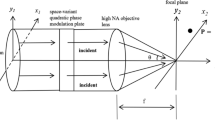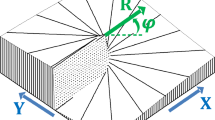In the theory of radiation emitted by bunches of charged particles, the effects of coherence are commonly taken into account by multiplying the intensity of radiation generated by a single particle by the form factor of the bunch, which depends on its size, shape, and particle distribution. Here, it is demonstrated that this approach is, generally speaking, incorrect for polarization radiation from a wide class of structures like photonic crystals and metasurfaces. The theory of coherent Smith–Purcell radiation from such structures has been developed. It is shown that the commonly accepted approach is applicable only under two conditions: (i) the observation point lies in the plane containing the trajectory of the bunch and the normal to the surface of the target, and (ii) the radius of the bunch is much smaller than the effective range of the Coulomb field of the moving electrons.



Similar content being viewed by others
REFERENCES
A. P. Potylitsyn, JETP Lett. 103, 669 (2016).
A. P. Potylitsyn, B. A. Alekseev, A. V. Vukolov, M. V. Shevelev, A. A. Baldin, V. V. Bleko, P. V. Karataev, and A. S. Kubankin, JETP Lett. 115 (2022, in press).
R. Kieffer, L. Bartnik, M. Bergamaschi, V. V. Bleko, M. Billing, L. Bobb, J. Conway, M. Forster, P. Karataev, A. S. Konkov, R. O. Jones, T. Lefevre, J. S. Markova, S. Mazzoni, Y. Padilla Fuentes, A. P. Potylitsyn, J. Shanks, and S. Wang, Phys. Rev. Lett. 121, 054802 (2018).
P. Karataev, G. Naumenko, A. Potylitsyn, M. Shevelev, and K. Artyomov, Results Phys. 33, 105079 (2022).
V. P. Shestopalov, Diffractive Electronics (Vishcha Shkola, Khar’kov, 1976) [in Russian].
A. A. Tishchenko and D. Yu. Sergeeva, JETP Lett. 110, 638 (2019).
P. Tonkaev and Yu. Kivshar, JETP Lett. 112, 615 (2020).
Z. Miao, Q. Wu, X. Li, Q. He, K. Ding, Z. An, Y. Zhang, and L. Zhou, Phys. Rev. X 5, 041027 (2015).
A. C. Overvig, S. C. Malek, and N. Yu, Phys. Rev. Lett. 125, 017402 (2020).
Y. Kurman and I. Kaminer, Nat. Phys. 16, 868 (2020).
A. Pizzi, G. Rosolen, L. J. Wong, R. Ischebeck, M. Soljačić, T. Feurer, and I. Kaminer, Adv. Sci. 7, 1901609 (2020).
Y. Kurman, R. Dahan, H. H. Sheinfux, K. Wang, M. Yannai, Y. Adiv, O. Reinhardt, L. H. Tizei, S. Y. Woo, and J. Li, Science (Washington, DC, U. S.) 372, 1181 (2021).
S. J. Smith and E. M. Purcell, Phys. Rev. 92, 1069 (1953).
V. P. Shestopalov, The Smith–Purcell Effect (Nova Science, New York, 1998).
P. Rullhusen, X. Artru, and P. Dhez, Novel Radiation Sources Using Relativistic Electrons (World Scientific, Singapore, 1998).
A. P. Potylitsyn, M. I. Ryazanov, M. N. Strikhanov, and A. A. Tishchenko, Diffraction Radiation from R-elativistic Particles, Springer Tracts Mod. Phys. 239 (2010).
V. G. Veselago, Phys. Usp. 54, 1161 (2011).
N. Horiuchi, T. Ochiai, J. Inoue, Y. Segawa, Y. Shibata, K. Ishi, Y. Kondo, M. Kanbe, H. Miyazaki, F. Hinode, S. Yamaguti, and K. Ohtaka, Phys. Rev. E 74, 056601 (2006).
S. Yamaguti, J. Inoue, O. Haeberlé, and K. Ohtaka, Phys. Rev. B 66, 195202 (2002).
T. Ochiai and K. Ohtaka, Phys. Rev. B 69, 125106 (2004).
K. Yamamoto, R. Sakakibara, S. Yano, Y. Segawa, Y. Shibata, K. Ishi, T. Ohsaka, T. Hara, Y. Kondo, H. Miyazaki, F. Hinode, T. Matsuyama, S. Yamaguti, and K. Ohtaka, Phys. Rev. E 69, 045601(R) (2004).
T. Ochiai and K. Ohtaka, Opt. Express 13, 7683 (2005).
D. Yu. Sergeeva, A. A. Tishchenko, and M. N. Strikhanov, Nucl. Instrum. Methods Phys. Res., Sect. B 402, 206 (2017).
D. I. Garaev, D. Yu. Sergeeva, and A. A. Tishchenko, Phys. Rev. B 103, 075403 (2021).
D. Yu. Sergeeva, A. S. Aryshev, A. A. Tishchenko, K. E. Popov, N. Terunuma, and J. Urakawa, Opt. Lett. 46, 544 (2021).
Funding
This study was supported by the Russian Science Foundation, project nos. 21-72-00113 (D. Sergeeva, Sections 2 and 3) and 17-72-20013 (A. Tishchenko, Sections 1 and 4).
Author information
Authors and Affiliations
Corresponding author
Ethics declarations
The authors declare that they have no conflicts of interest.
Additional information
Translated by M. Skorikov
Rights and permissions
About this article
Cite this article
Sergeeva, D.Y., Tishchenko, A.A. Does a Form Factor in Smith–Purcell Radiation Exist Always?. Jetp Lett. 115, 713–719 (2022). https://doi.org/10.1134/S0021364022600847
Received:
Revised:
Accepted:
Published:
Issue Date:
DOI: https://doi.org/10.1134/S0021364022600847




